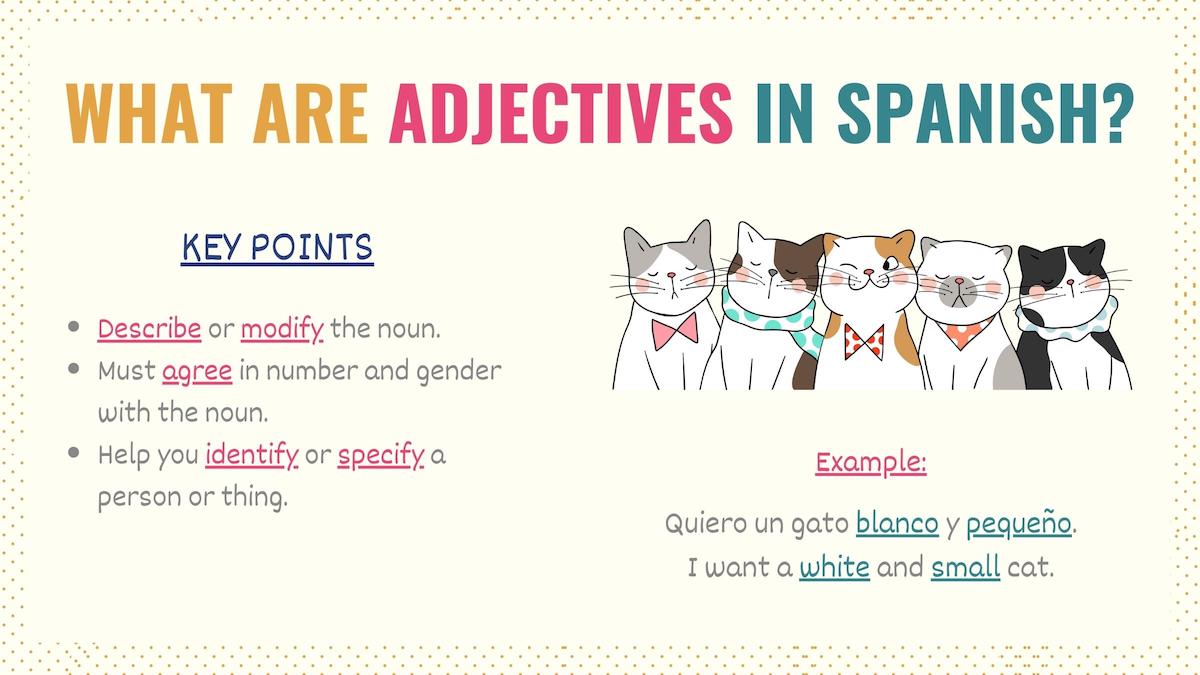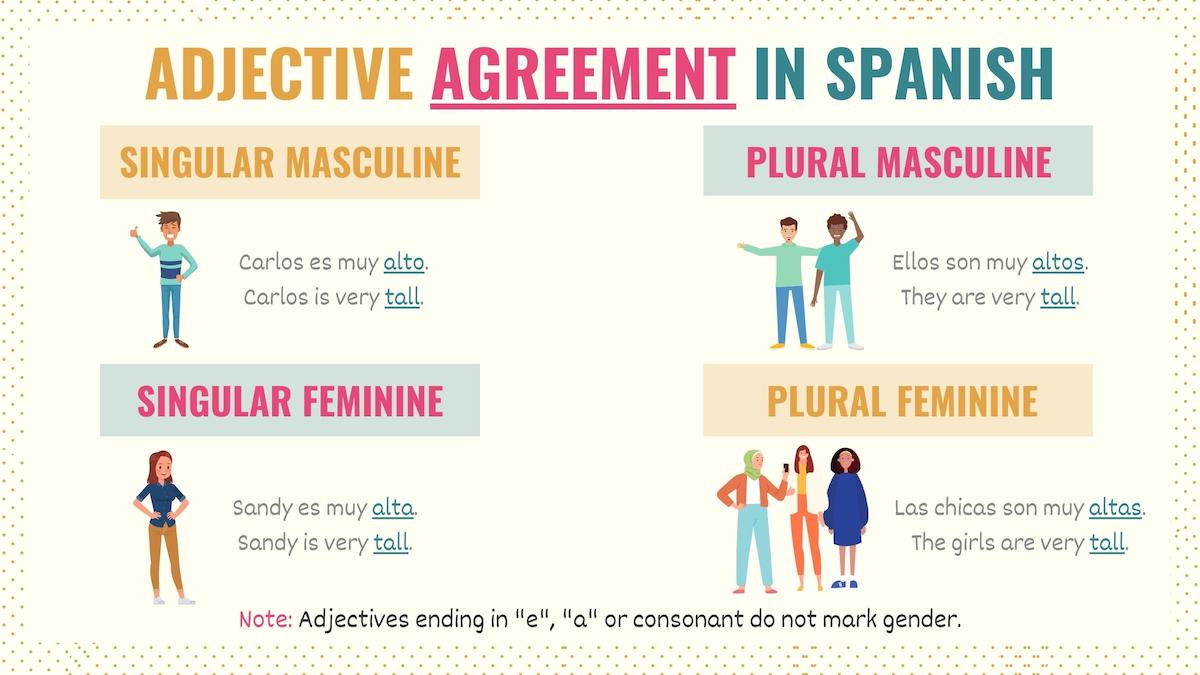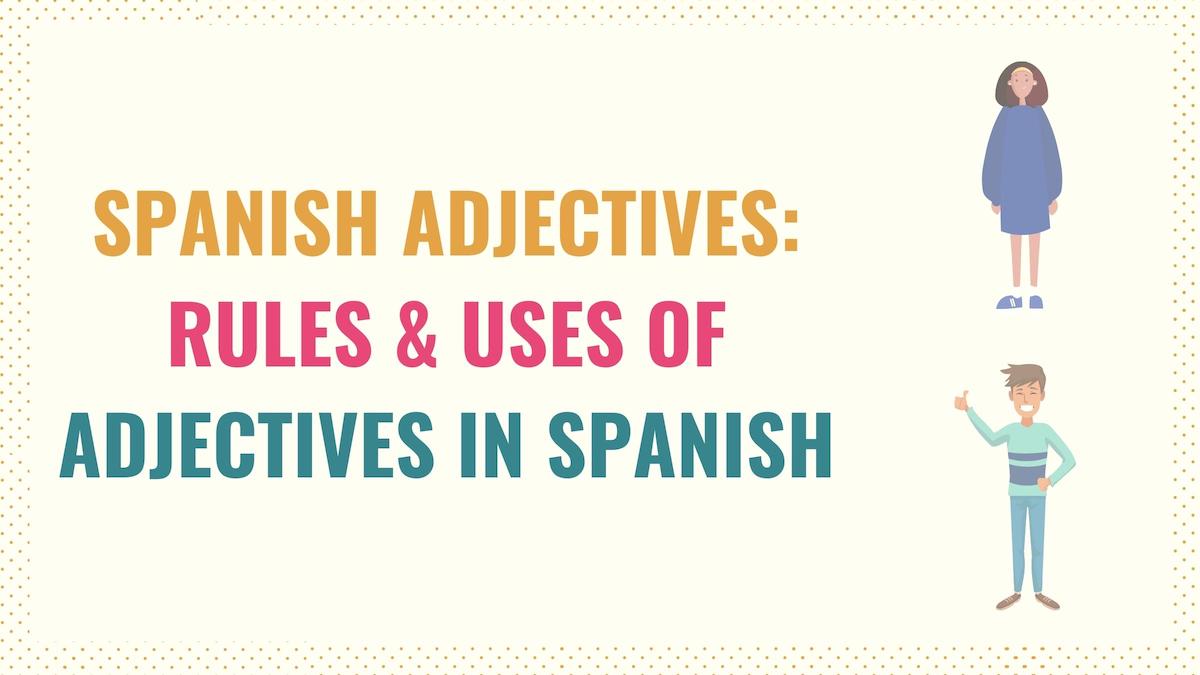Spanish adjectives are the part of speech responsible for producing richer and more descriptive sentences. With them, your communication will be much more effective. To help you understand what adjectives are and why they are important, on this page, you’ll find:
- What Are Adjectives
- Examples of Basic Adjectives in Spanish
- Adjective Agreement Rules
- Next Steps & Resources for Adjectives
The information on this page is designed to be a starting point for your study of this topic. I encourage you to explore the linked resources to deepen your understanding of adjectives in Spanish.
What Is an Adjective in Spanish?
A Spanish adjective is a word that describes or modifies nouns, providing additional information about their qualities or states.

For instance:
El celular rojo es mío.
The red phone is mine.
La comida está muy caliente.
The food is very hot.
Rachel compró muchas camisas.
Rachel bought many shirts.
As shown in the sentences above, adjectives in Spanish complement nouns and help identify them. For example, the adjective rojo specifies the phone you’re referring to.
Although they’re usually associated with Spanish nouns, adjectives are also used to describe pronouns:
Ellas no son amables.
They are not nice.
La chica te queda mejor.
The small one suits you better.
¿Cuál carro te gusta? A mí me gusta el azul.
Which car do you like? I like the blue one.
Take Note: Pronouns in Spanish replace nouns and acquire their characteristics. So, if the noun you replaced is singular masculine, the words that replace and modify that word must also be singular masculine.
As you’ll learn in the sections below, there are different types of adjectives based on the information they provide.
Type of Spanish Adjectives
Adjectives in Spanish have different classifications depending on their role in the sentence.
Qualifying or Descriptive Adjectives
Qualifying or descriptive adjectives convey how something or someone is. Simply put, these words are related to color, shape, nationality, size, personality, and physical characteristics. Here are examples of the most common adjectives that fall into this category:
- Amable: Kind
- Alemán: German
- Blanco: White
- Bonito: Pretty
- Caliente: Hot
- Caro: Expensive
- Chico: Small
- Feo: Ugly
- Grande: Big
- Inteligente: Intelligent
- Viejo: Old
Tus vecinas son alemanas.
Your neighbors are German.
Luca tiene un perro blanco.
Luca has a white dog.
La comida en este lugar es muy cara.
The food in this place is very expensive.
Limiting Adjectives or Determiners
Limiting adjectives or determiners specify or define the scope of a noun. This type of adjective provides information about possession, proximity, and amounts. Examples of these pronouns are:
- Aquel: That
- Algunos: Some
- Dos: Two
- Este: This
- Mi: My
- Mucho: Many / A lot
- Poco: Few / Little
Hay poca agua.
There’s little water.
Perdí muchas monedas.
I lost many coins.
¿Ese niño es tu hijo?
Is that kid your son?
Take Note: When expressing the amount of something, you can use numbers in Spanish to provide a precise quantity. However, you must use indefinite words if you don’t know or want to refer to specific amounts.
Interrogative Adjectives
An interrogative adjective, known as Spanish question words, allows you to ask questions about a noun. Most of these terms do not follow the adjective agreement rules (don’t have a plural form or mark gender).
Qué, cuál and cuántos are interrogative adjectives:
¿Cuál película prefieres?
Which movie do you prefer?
¿Qué ciudades has visitado?
What cities have you visited?
¿Cuántos kilos de manzana compraste?
How many kilos of apples did you buy?
Grammar Rules: Adjective Agreement in Spanish

Adjective agreement Spanish rules are one of the most important things you must remember when using an adjective. This Spanish grammar rule establishes that adjectives must agree with the number and gender of the noun they describe.
Simply put, if you’re using masculine, singular, feminine, or plural nouns, adjectives must change to reflect this information.
The sentences below use the same descriptive word with different nouns. Check how this noun-adjective agreement rule kicks in:
¡Qué vista tan bonita!
Such a pretty view!
Sus zapatos son muy bonitos.
Her shoes are very pretty.
Josh es guapo e inteligente.
Josh is handsome and smart.
Tus amigas son bonitas e inteligentes.
Your friends are pretty and smart.
Spanish adjectives use the same rules for gender as nouns. In summary, an adjective doesn’t mark gender if it naturally ends with:
- E
- Consonant
- A
So, with this type of adjective, you’ll use the same word for feminine and masculine nouns.
Juan es muy optimista.
Juan is very optimistic.
Esa señora no es nada optimista.
That lady is not optimistic at all.
Take Note: Check this guide to plural words to know how to make an adjective plural.
Additional Resources for Adjectives in Spanish
Here is a list of additional guides that can help you improve your language skills and command of Spanish adjectives:
- Comparatives and superlatives: When describing a quality, you can compare it in relation to another person or thing. In this guide, you’ll learn how to use comparative and superlative adjectives to contrast or measure attributes between two or more things.
- Adjective Placement: As you probably noticed, the position of an adjective in Spanish is different from English. So, this resource is meant to help you understand how these rules work.
- Past participles: In Spanish, past participles are not only used to form compound tenses. These words are also used to describe the physical or emotional state of something. In this guide, you’ll learn how to create them and when to use them.
- List of common adjectives: If you don’t know what vocabulary you should be learning, in this guide, you’ll find a curated list of basic adjectives you must know.
- Determiner words: Like adjectives, determiners in Spanish modify a noun and provide specific information about it. Possessive adjectives are an example of determiners. Check this resource to learn more about these essential words.
- Guide to Nouns: As you learned in this guide, these are the type of words that work with adjectives. So, in this guide, you’ll find all the information you need about nouns in Spanish.
Download the Spanish Adjectives PDF
Spanish adjectives are a key part of the language and essential for becoming conversationally proficient in Spanish. I’ve compiled a free PDF you can download for this guide to adjectives along. That way you can come back to it at your own convenience when you’re ready to level up your language skills with Spanish adjectives.



